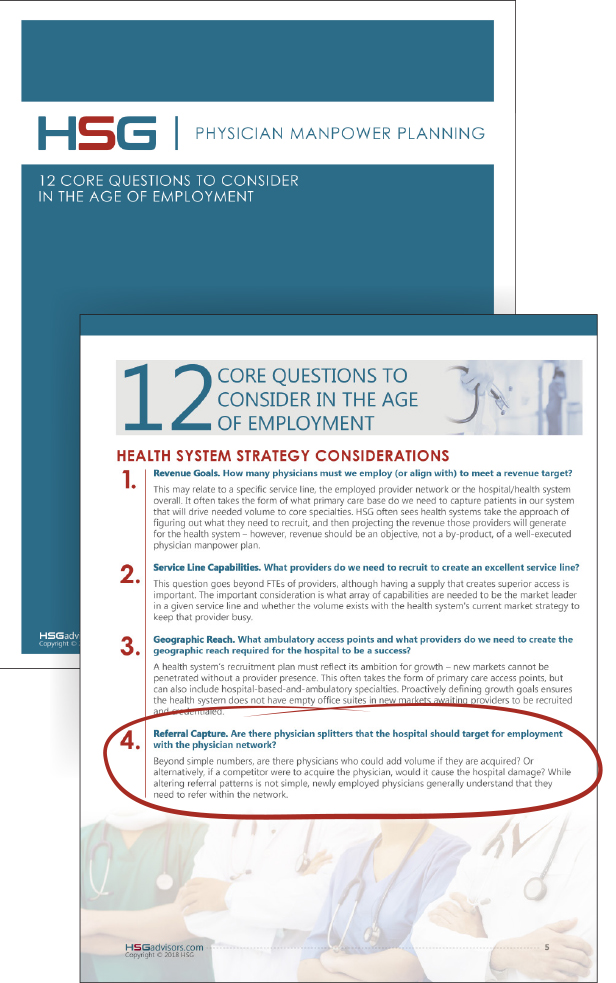
|
Download a PDF of this article to share with your team |
Improving Manpower Planning with Analytics is Most Effective with Claims-Based Patient Data

HSG recommends health systems that are working on improving manpower planning with analytics should evaluate their strategic physician manpower needs through three questions:
- Can we achieve our growth goals through utilization of existing provider capacity?
- Can we achieve our growth goals through shifting the alignment of providers and/or patients to our health system?
- If the answers to questions 1 and 2 are “no,” do we need to recruit incremental providers to compete in the market?
While questions 1 and 3 are often well-addressed, question 2 often gets overlooked by most health systems. This largely relates to the paucity of accurate and timely data that provides the depth needed to make strategic decisions about patient capture. Many CRM or Referral Management platforms give directional data into how physicians refer patients – however they lack the depth of accurate and timely data to make strategic decisions about Physician Manpower. As such, health system leadership teams often leave this type of data siloed within their physician liaison or other outreach programs and do not integrate it into strategically crucial areas.
HSG Physician Network Integrity Analytics® helps health systems move past these problems and provide an in-depth assessment, at the patient-level, of how patients utilize health system and competitor services and providers. HSG’s capability to drill down to the CPT or ICD-10 level on data that is less than 30 days old, while uniquely identifying patients and their provider interactions, provides a level of detail that enables health systems to confidently answer the question “Can we achieve our growth goals through shifting the alignment of providers and/or patients to our health system?”
In HSG’s work with health systems on Manpower Planning or Medical Staff Development Planning, the following questions are commonly addressed through the use of HSG Physician Network Integrity Analytics®:
How Many of Our Primary Care Patients Are Seeking Care Outside of Our Network?
Many organizations can measure, at some level, physician-to-physician referrals, but this level of data does not capture the full-range of provider interactions patients have with independent providers or services from competitor systems.
Why it matters to manpower planning
Evaluating trends in patients leaving the network (by service, by geography) and evaluating what providers they are seeing outside of your network provides direct insight into whether growth can be achieved with incremental recruitment…or if recruitment will simply give your health system more capacity with no patients to fill it.
What is Our Market Share for Ambulatory Visits by Specialty?
Historically, health systems have struggled to define ambulatory market share, given that most state hospital associations do not aggregate or report on this data. This has led to health systems using inpatient market share as a proxy for market penetration. In some cases, this is fine – in a health system with robust service offerings in a non-competitive market with a limited geographic area, these numbers should correlate fairly well. However, measuring ambulatory market share provides different insights in markets where:
- The health system has a geographic growth strategy that places ambulatory access points far from inpatient services.
- There is intense service line competition amongst two or more health systems, especially those that have variability in the strength of core service line offerings.
- The payer market has trended towards a reasonable percentage of population health management, where capturing lives is more important than inpatient market share.
Evaluating and measuring growth goals through an ambulatory market share focus will reveal different insights about your providers – and may result in insights that substantially change your provider growth needs.
Where Do Independent Providers in Our Market Send Their Patients and Take Their Cases?
Understanding the practice dynamics of independent practices has historically been a challenge for health systems. In most cases, health systems are making decisions in the dark about whether they should continue to collaborate with or compete with independent providers who are generating volume for the health system – but may not be generating “enough” volume to hit service line and overall revenue targets. Evaluating the patient/case capture from each independent practice in a health system’s market provides a clear picture of what alignment needs to occur to hit targets.
- If that alignment is achievable, the health system may opt to forgo expensive, risky recruitment of incremental providers.
- If that alignment is not achievable, the health system knows it will have to increase its financial commitment by growing its own employed provider complement or supporting recruitment to aligned independent practices to compete for the market share it needs to hit revenue targets.
Health systems looking to embark on a Physician Manpower Plan or Medical Staff Development Plan should evaluate whether their historical process enables them to answer these important questions. HSG Physician Network Integrity Analytics can provide an accurate, timely and in-depth picture of the provider and patient dynamics in a market, allowing for optimal manpower planning decisions to be made.
We want to help your physician network evolve through your Physician Manpower Planning and Recruitment Strategy in order to maximize your health system’s performance.
Contact Travis Ansel at (502) 814-1182 in order to discuss improving manpower planning with analytics focused on your specific patient population and their healthcare utilization.
Related Case Study for Improving Manpower Planning with Analytics
This case study emphasizes five core analytic areas that were utilized throughout the manpower planning process. Physician needs based on market demand, geographic analyses, patient leakage measurement, employed primary care throughout, and advanced practice provider utilization were all review in depth through the manpower planning process. The analysis lead to a 200% growth in employed primary care providers over a 5-year period.
